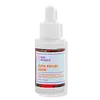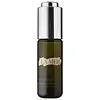What's inside
What's inside
 Key Ingredients
Key Ingredients

 Benefits
Benefits

 Concerns
Concerns

No concerns
 Ingredients Side-by-side
Ingredients Side-by-side

Water
Skin ConditioningPropanediol
SolventGlycerin
HumectantAmmonium Acryloyldimethyltaurate/Vp Copolymer
1,2-Hexanediol
Skin ConditioningDiheptyl Succinate
EmollientCapryloyl Glycerin/Sebacic Acid Copolymer
Skin ConditioningGlycine
BufferingXanthan Gum
EmulsifyingEthylhexylglycerin
Skin ConditioningCaprylyl Glycol
EmollientAcetyl Hexapeptide-8
HumectantAcetyl Octapeptide-3
HumectantSodium Hyaluronate
HumectantCopper Tripeptide-1
Skin ConditioningTocopherol
AntioxidantWater, Propanediol, Glycerin, Ammonium Acryloyldimethyltaurate/Vp Copolymer, 1,2-Hexanediol, Diheptyl Succinate, Capryloyl Glycerin/Sebacic Acid Copolymer, Glycine, Xanthan Gum, Ethylhexylglycerin, Caprylyl Glycol, Acetyl Hexapeptide-8, Acetyl Octapeptide-3, Sodium Hyaluronate, Copper Tripeptide-1, Tocopherol
Water
Skin ConditioningPropanediol
SolventAlgae Extract
EmollientGlycerin
HumectantPrunus Amygdalus Dulcis Seed Extract
Skin ConditioningSesamum Indicum Seed Oil
EmollientMedicago Sativa Seed Powder
Skin ConditioningHelianthus Annuus Seedcake
AbrasivePrunus Amygdalus Dulcis Seed Meal
AbrasiveEucalyptus Globulus Leaf Oil
PerfumingSodium Gluconate
Skin ConditioningCopper Gluconate
Skin ConditioningMagnesium Gluconate
Skin ConditioningCalcium Gluconate
HumectantZinc Gluconate
Skin ConditioningTocopheryl Succinate
AntioxidantNiacin
SmoothingSesamum Indicum Seed Powder
Skin ConditioningSucrose
HumectantPyrus Malus Fruit Extract
Skin ConditioningCitrullus Lanatus Fruit Extract
Skin ConditioningPorphyridium Cruentum Extract
Skin ConditioningLens Esculenta Fruit Extract
Skin ConditioningLaminaria Digitata Extract
Skin ProtectingSaccharomyces Lysate Extract
HumectantAscophyllum Nodosum Extract
Skin ConditioningPlankton Extract
Skin ConditioningCitrus Aurantifolia Peel Extract
CleansingTourmaline
Sigesbeckia Orientalis Extract
Skin ConditioningAsparagopsis Armata Extract
Skin ProtectingAcetyl Hexapeptide-8
HumectantCaffeine
Skin ConditioningPullulan
Trehalose
HumectantSodium Lactate
BufferingSorbitol
HumectantSodium PCA
HumectantStyrene/Vp Copolymer
Hydroxypropyl Methylcellulose
Emulsion StabilisingSodium Hyaluronate
HumectantHexylene Glycol
EmulsifyingButylene Glycol
HumectantVinyl Dimethicone/Methicone Silsesquioxane Crosspolymer
Alcohol Denat.
AntimicrobialXanthan Gum
EmulsifyingIsododecane
EmollientEthylhexylglycerin
Skin ConditioningCaprylyl Glycol
EmollientTrimethylsiloxysilicate
EmollientParfum
MaskingDisodium EDTA
Phenoxyethanol
PreservativePotassium Sorbate
PreservativeSodium Benzoate
MaskingCI 61570
Cosmetic ColorantCI 42090
Cosmetic ColorantWater, Propanediol, Algae Extract, Glycerin, Prunus Amygdalus Dulcis Seed Extract, Sesamum Indicum Seed Oil, Medicago Sativa Seed Powder, Helianthus Annuus Seedcake, Prunus Amygdalus Dulcis Seed Meal, Eucalyptus Globulus Leaf Oil, Sodium Gluconate, Copper Gluconate, Magnesium Gluconate, Calcium Gluconate, Zinc Gluconate, Tocopheryl Succinate, Niacin, Sesamum Indicum Seed Powder, Sucrose, Pyrus Malus Fruit Extract, Citrullus Lanatus Fruit Extract, Porphyridium Cruentum Extract, Lens Esculenta Fruit Extract, Laminaria Digitata Extract, Saccharomyces Lysate Extract, Ascophyllum Nodosum Extract, Plankton Extract, Citrus Aurantifolia Peel Extract, Tourmaline, Sigesbeckia Orientalis Extract, Asparagopsis Armata Extract, Acetyl Hexapeptide-8, Caffeine, Pullulan, Trehalose, Sodium Lactate, Sorbitol, Sodium PCA, Styrene/Vp Copolymer, Hydroxypropyl Methylcellulose, Sodium Hyaluronate, Hexylene Glycol, Butylene Glycol, Vinyl Dimethicone/Methicone Silsesquioxane Crosspolymer, Alcohol Denat., Xanthan Gum, Isododecane, Ethylhexylglycerin, Caprylyl Glycol, Trimethylsiloxysilicate, Parfum, Disodium EDTA, Phenoxyethanol, Potassium Sorbate, Sodium Benzoate, CI 61570, CI 42090
 Reviews
Reviews

Ingredients Explained
These ingredients are found in both products.
Ingredients higher up in an ingredient list are typically present in a larger amount.
Acetyl Hexapeptide-8, commonly known as Argireline or Acetyl Hexapeptide-3, is a popular peptide in skincare. It’s often referred to as a “Botox-like” ingredient because it helps reduce muscle movement.
By relaxing these micro-movements, Argireline may help minimize the appearance of fine lines and wrinkles. That said, it’s not as powerful as Botox, and research on its long-term effectiveness is still limited.
Beyond smoothing, Argireline may also support collagen production. Collagen is the protein that helps keep your skin firm, bouncy, and well-hydrated by strengthening the skin barrier.
So while Argireline isn’t a miracle fix, it can be a helpful addition to a routine focused on both prevention and skin health.
Read more about other common types of peptides here:
Learn more about Acetyl Hexapeptide-8Caprylyl Glycol is a humectant and emollient, meaning it attracts and preserves moisture.
It is a common ingredient in many products, especially those designed to hydrate skin. The primary benefits are retaining moisture, skin softening, and promoting a healthy skin barrier.
Though Caprylyl Glycol is an alcohol derived from fatty acids, it is not the kind that can dry out skin.
This ingredient is also used as a preservative to extend the life of products. It has slight antimicrobial properties.
Learn more about Caprylyl GlycolEthylhexylglycerin (we can't pronounce this either) is commonly used as a preservative and skin softener. It is derived from glyceryl.
You might see Ethylhexylglycerin often paired with other preservatives such as phenoxyethanol. Ethylhexylglycerin has been found to increase the effectiveness of these other preservatives.
Glycerin is already naturally found in your skin. It helps moisturize and protect your skin.
A study from 2016 found glycerin to be more effective as a humectant than AHAs and hyaluronic acid.
As a humectant, it helps the skin stay hydrated by pulling moisture to your skin. The low molecular weight of glycerin allows it to pull moisture into the deeper layers of your skin.
Hydrated skin improves your skin barrier; Your skin barrier helps protect against irritants and bacteria.
Glycerin has also been found to have antimicrobial and antiviral properties. Due to these properties, glycerin is often used in wound and burn treatments.
In cosmetics, glycerin is usually derived from plants such as soybean or palm. However, it can also be sourced from animals, such as tallow or animal fat.
This ingredient is organic, colorless, odorless, and non-toxic.
Glycerin is the name for this ingredient in American English. British English uses Glycerol/Glycerine.
Learn more about GlycerinPropanediol is an all-star ingredient. It softens, hydrates, and smooths the skin.
It’s often used to:
Propanediol is not likely to cause sensitivity and considered safe to use. It is derived from corn or petroleum with a clear color and no scent.
Learn more about PropanediolSodium Hyaluronate is hyaluronic acid's salt form. It is commonly derived from the sodium salt of hyaluronic acid.
Like hyaluronic acid, it is great at holding water and acts as a humectant. This makes it a great skin hydrating ingredient.
Sodium Hyaluronate is naturally occurring in our bodies and is mostly found in eye fluid and joints.
These are some other common types of Hyaluronic Acid:
Learn more about Sodium HyaluronateWater. It's the most common cosmetic ingredient of all. You'll usually see it at the top of ingredient lists, meaning that it makes up the largest part of the product.
So why is it so popular? Water most often acts as a solvent - this means that it helps dissolve other ingredients into the formulation.
You'll also recognize water as that liquid we all need to stay alive. If you see this, drink a glass of water. Stay hydrated!
Learn more about WaterXanthan gum is used as a stabilizer and thickener within cosmetic products. It helps give products a sticky, thick feeling - preventing them from being too runny.
On the technical side of things, xanthan gum is a polysaccharide - a combination consisting of multiple sugar molecules bonded together.
Xanthan gum is a pretty common and great ingredient. It is a natural, non-toxic, non-irritating ingredient that is also commonly used in food products.
Learn more about Xanthan Gum